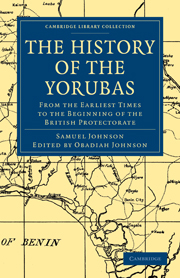Book contents
- Frontmatter
- AUTHOR'S PREFACE
- EDITOR'S PREFACE
- Contents
- 1 INTRODUCTION
- 2 THE YORUBA LANGUAGE
- 3 A SKETCH OF YORUBA GRAMMAR
- PART I THE PEOPLE, COUNTRY, AND THE LANGUAGE
- CHAPTER I ORIGIN AND EARLY HISTORY
- CHAPTER II THE ORIGIN OF THE TRIBES
- CHAPTER III RELIGION
- CHAPTER IV GOVERNMENT
- CHAPTER V YORUBA NAMES
- CHAPTER VI YORUBA TOWNS AND VILLAGES
- CHAPTER VII THE PRINCIPLES OF LAND LAW
- CHAPTER VIII MANNERS AND CUSTOMS
- PART II
- APPENDIX A TREATIES AND AGREEMENTS
- APPENDIX B
- INDEX
CHAPTER VIII - MANNERS AND CUSTOMS
Published online by Cambridge University Press: 05 July 2011
- Frontmatter
- AUTHOR'S PREFACE
- EDITOR'S PREFACE
- Contents
- 1 INTRODUCTION
- 2 THE YORUBA LANGUAGE
- 3 A SKETCH OF YORUBA GRAMMAR
- PART I THE PEOPLE, COUNTRY, AND THE LANGUAGE
- CHAPTER I ORIGIN AND EARLY HISTORY
- CHAPTER II THE ORIGIN OF THE TRIBES
- CHAPTER III RELIGION
- CHAPTER IV GOVERNMENT
- CHAPTER V YORUBA NAMES
- CHAPTER VI YORUBA TOWNS AND VILLAGES
- CHAPTER VII THE PRINCIPLES OF LAND LAW
- CHAPTER VIII MANNERS AND CUSTOMS
- PART II
- APPENDIX A TREATIES AND AGREEMENTS
- APPENDIX B
- INDEX
Summary
SOCIAL POLITY
The ancient Yorubas were very simple in their manners, their tastes, and habits. Their houses all on the ground floor are built in compounds called Agbo Ile (lit. a flock of houses), that is to say in the form of a hollow square, horse shoe or a circle, enclosing a large central area, with one principal gateway the house being divided into compartments to hold several families, all more or less related or united by ties of kinship, or friendship. One piazza runs right round the whole, and is used for all ordinary purposes by day, and for the reception of visitors. The central area is used in common by all the inmates for general purposes; usually horses, sheep and goats are found tethered in it.
The compartment of the head of the house is usually opposite the main gateway or a little to the right. It is larger, the roof loftier and the piazza more spacious than the rest. Here the master is expected to be found at all times (during visiting hours) by a doorway which leads to his harem at the back of the house. This particular doorway is known as where the master “shows his face” (for the reception of visitors); it is an essential adjunct to the houses of chiefs or important personages, being used for no other purpose, for at all other times it is kept closed.
- Type
- Chapter
- Information
- The History of the YorubasFrom the Earliest Times to the Beginning of the British Protectorate, pp. 98 - 140Publisher: Cambridge University PressPrint publication year: 2010First published in: 1921



